Summary Med surg ATI (study guide; latest Fall 2020, A+ help
Document Content and Description Below
Med surg ATI|Solano Community College - NURSING nursing 1 • Accident/Error/Injury Prevention - (1) o Spinal Cord Injury: Care of a Client who has a Halo Device (Active Learning Template - Therapeuti... c Procedure, RM AMS RN 10.0 Chp 16) o The purpose is to provide traction and/or immobilize the spinal column Do not use the halo device to turn or move a client If the client goes home with a halo fixation device on, provide instruction on pin and vest care. Teach the client signs of infection and skin breakdown. Maintain body alignment and ensure cervical tong weights hang freely. Monitor skin integrity by providing pin care and assessing the skin under the halo fixation vest as appropriate. • Standard Precautions/Transmission-Based Precautions/Surgical Asepsis - (1) o Bacterial, Viral, Fungal, and Parasitic Infections: Isolation Precautions for Client Who Has Influenza (Active Learning Template - Basic Concept, RM FUND RN 9.0 Ch 56) Contact: Clostridium difficile, herpes simplex virus, impetigo, methicillin‑resistant Staphylococcus aureus (MRSA), vancomycin‑resistant Staphylococcus aureus (VRSA) Airborne: Measles, varicella, tuberculosis Droplet (3-6 ft): Haemophilus influenzae type B (Hib), pertussis, mumps, rubella, plague, streptococcal pneumonia, meningococcal pneumonia • Tuberculosis: Priority Action for a Client in the Emergency Department (Active Learning Template - System Disorder, RM AMS RN 10.0 Chp 23) Administer heated and humidified oxygen therapy as prescribed The client should be transported using the shortest and least busy route cough and expectorate sputum into tissues that are disposed of by the client into provided plastic bags or no‑touch receptacles Clients are no longer considered infectious after three consecutive negative sputum cultures • Adverse Effects/Contraindications/Side Effects/Interactions - (1) o Electrolyte Imbalances: Manifestations of Hypokalemia (Active Learning Template - Medication, RM AMS RN 10.0 Chp 44) VITAL SIGNS: Decreased blood pressure, thready weak pulse, orthostatic hypotension NEUROLOGIC: Altered mental status, anxiety, and lethargy that progresses to acute confusion and coma ECG: Flattened T wave, prominent U waves, ST depression, prolonged PR interval GASTROINTESTINAL: Hypoactive bowel sounds, nausea, vomiting, constipation, abdominal distention. Paralytic ileus can develop. MUSCULAR: Weakness. Deep‑tendon reflexes can be reduced. RESPIRATORY: Shallow breathing • Blood and Blood Products - (1) o Blood and Blood Product Transfusions: Steps to Administer a Blood Transfusion (Active Learning Template - Therapeutic Procedure, RM AMS RN 10.0 Chp 40) ● Verify the prescription for a specific blood product. ● Obtain consent for procedure if required. ● Obtain blood samples for compatibility determination, such as type and cross‑match. ● Assess for a history of blood‑transfusion reactions. ● Initiate large‑bore IV access. An 18‑ or 20‑gauge needle is standard for administering blood products. ● Obtain blood products from the blood bank. Inspect the blood for discoloration, excessive bubbles, or cloudiness. ● Prior to transfusion, two RNs must identify the correct blood product and client by looking at the hospital identification number (noted on the blood product) and the number identified on the client’s identification band to make sure the numbers match. ● The nurse completing the blood product verification must be one of the nurses who administers the blood product. ● Prime the blood administration set with 0.9% sodium chloride only. Never add medications to blood products. Y‑tubing with a filter is used to transfuse blood. ● Begin the transfusion, and use a blood warmer if indicated. Initiate the transfusion within 30 min of obtaining the blood product to reduce the risk of bacterial growth. • Central Venous Access Devices - (2) o Cardiovascular Diagnostic and Therapeutic Procedures: Administering Medication Through a Nontunneled Percutaneous Central Catheter (Active Learning Template - Therapeutic Procedure, RM AMS RN 10.0 Chp 27) Insertion location: subclavian vein, jugular vein; tip in the distal third of the superior vena cava Indications: Short-term use only administration of blood, long‑term administration of chemotherapeutic agents, antibiotics, and total parenteral nutrition o Cardiovascular Diagnostic and Therapeutic Procedures: Removing a Peripherally Inserted Central Catheter (Active Learning Template - Therapeutic Procedure, RM AMS RN 10.0 Chp 27) Length of use: up to 12 months Assess Picc line every 8 hrs Change tubes and caps every 3 days Follow facility protocol for dressing changes, usually every 7 days and when indicated (wet, loose, soiled). • Expected Actions/Outcomes - (1) o Electrolyte Imbalances: Effective Action of Magnesium Sulfate (Active Learning Template - Medication, RM AMS RN 10.0 Chp 44) IV route is used because IM can cause pain and tissue damage Oral magnesium can cause diarrhea and increase magnesium depletion Monitor Deep Tendon Reflex (DTR) hourly during administration of magnesium sulfate. IV magnesium sulfate is given via an infusion pump not to exceed 150 mg/min, or 67 mEq over an 8‑hr period Clients receiving digitalis should be monitored closely if magnesium is low because it predisposes the client to digitalis toxicity. • Medication Administration - (1) o Heart Failure and Pulmonary Edema: Client Teaching on Use of Furosemide (Active Learning Template - Medication, RM AMS RN 10.0 Chp 32) Use to decrease preload Teach clients taking loop or thiazide diuretics to ingest foods and drinks that are high in potassium to counter the effects of hypokalemia. • Total Parenteral Nutrition (TPN) - (1) o Electrolyte Imbalances: Adequate Nutritional Status with Total Parenteral Nutrition (Active Learning Template - Therapeutic Procedure, RM AMS RN 10.0 Chp 44) The purpose of TPN administration is to prevent or correct nutritional deficiencies and minimize the adverse effects of malnourishment. Hypertonic IV bolus solution. TPN contains complete nutrition, including calories in a high concentration (10% to 50%) of dextrose, lipids/essential fatty acids, protein, electrolytes, vitamins, and trace elements. INDICATIONS Any condition that ●● Affects the ability to absorb nutrition. ●● Has a prolonged recovery. ●● Creates a hypermetabolic state. ●● Creates a chronic malnutrition. • Diagnostic Tests - (1) o Neurologic Diagnostic Procedures: Preparing a Client for a Lumbar Puncture (Active Learning Template - Diagnostic Procedure, RM AMS RN 10.0 Chp 3) The risks versus benefits of a lumbar puncture should be discussed with the client prior to this procedure. DO NOT perform when pt has ICP or bleeding disorder or on anticoagulant Nursing Actions Ensure that all of the client’s jewelry is removed and that the client is wearing only a hospital gown Void prior to procedure Position Pt in “cannonball while on one side” or “stretch over an overbed table when sitting” • System Specific Assessments - (1) o Burns: Priority Action During Resuscitation Phase (Active Learning Template - System Disorder, RM AMS RN 10.0 Chp 75) Emergent (resuscitative phase) Begins with the injury and continues for 24 to 48 hr. Priorities include securing the airway, supporting circulation and organ perfusion by fluid replacement, managing pain, preventing infection through wound care, maintaining body temperature, and providing emotional support. • Alterations in Body Systems - (4) o Respiratory Management and Mechanical Ventilation: Caring for a Client Who Has an Endotracheal Tube (Active Learning Template - Therapeutic Procedure, RM AMS RN 10.0 Chp 19) Use caution when moving the client Apply protective barriers (soft wrist restraints) according to hospital protocol to prevent self‑extubation Use two staff members for repositioning and to resecuring the tube. Suction oral and tracheal secretions to maintain tube patency Have a resuscitation bag with a face mask available at the bedside at all times in case of ventilator malfunction or accidental extubation Support ventilator tubing to prevent mucosal erosion and displacement. Document tube placement in centimeters at the client’s teeth or lips. Assess respiratory status every 1 to 2 hr: Monitor and document ventilator settings hourly Never turn off ventilator alarms. Assess the cuff pressure at least every 8 hr. Maintain below 20 mm Hg Assess for an air leak around the cuff (client speaking, air hissing, or decreasing SaO2) o Chest Tube Insertion and Monitoring: Maintaining Drainage System (Active Learning Template - Nursing Skill, RM AMS RN 10.0 Chp 18) Check the water seal level every 2 hr, and add fluid as needed. The fluid level should fluctuate with respiratory effort Document the amount and color of drainage hourly for the first 24 hr and then at least every 8 hr. Position the client in the semi‑to high‑Fowler’s position to promote optimal lung expansion and drainage of fluid from the lungs Administer pain medications as prescribed Do not strip or milk tubing; only perform this action when prescribed Tape all connections between the chest tube and chest tube drainage system. Keep two enclosed hemostats, sterile water, and an occlusive dressing located at the bedside at all times. o Cancer Treatment Options: Teaching About Skin Care Following Radiation Treatment (Active Learning Template - Therapeutic Procedure, RM AMS RN 10.0 Chp 91) Gently wash the skin over the irradiated area with mild soap and water. Dry the area thoroughly using patting motions Do not remove or wash off radiation tattoos (markings) used to guide therapy. Do not apply powders, ointments, lotions, deodorants, or perfumes to the irradiated skin. Wear soft clothing. Avoid tight or constricting clothes Do not expose the irradiated skin to sun or a heat source Inspect skin for evidence of damage and report to the provider o Meningitis: Planning Interventions for Care (Active Learning Template - System Disorder, RM AMS RN 10.0 Chp 5) Isolate the client in a private room as soon as meningitis is suspected. (droplet precaution) Continue droplet precautions til antibiotics have been administered for 24 hr and secretions are no longer infectious Clients who have bacterial meningitis might need to remain on droplet precautions continuously. Implement fever-reduction measures, such as a cooling blanket Decrease environmental stimuli.(quiet) Minimize exposure to bright light HOB 30 degrees avoid coughing and sneezing Seizure precaution Older adults @ Increase risk for pneumonia • Fluid and Electrolyte Imbalances - (1) o Hyperthyroidism: Caring for Client Following a Thyroidectomy (Active Learning Template - System Disorder, RM AMS RN 10.0 Chp 78) Keep the client in a semi-Fowler’s position. Support head and neck with pillows. Avoid neck extension. monitor vital signs typically every 15 min until stable then every 30 min. Assist with deep breathing exercises every 30 to 60 min Check the surgical dressing and back of the neck for excessive bleeding Check for laryngeal nerve damage by asking the client to speak as soon as awake from anesthesia and every 2 hr thereafter Reassure the client that discomfort will resolve within a few days Humidify air, assist to cough and deep breathe, and provide oral and tracheal suction if needed • Hemodynamics - (2) o Pacemakers: Evaluating Client Understanding of Discharge Teaching (Active Learning Template - Therapeutic Procedure, RM AMS RN 10.0 Chp 29) Carry a pacemaker identification card at all times Prevent wire dislodgement. (Wear sling when out of bed. Do not raise arm above shoulder for 1 to 2 weeks.) Take pulse daily at the same time. Notify the provider if heart rate is less than the pacemaker rate Report signs of dizziness, fainting, fatigue, weakness, chest pain, hiccupping, palpitations, difficulty breathing, or weight gain Resume sexual activity as desired, avoiding positions that put stress on the incision site No contact sports or heavy lifting for 2 months Notify airport security of it and no wand detector should be place over it Never place magnetic device over pacemaker For clients who have pacemaker‑defibrillators, when the device delivers a shock, anyone touching the client will feel a slight electrical impulse, but the impulse is not harmful o Electrocardiography and Dysrhythmia Monitoring: Identifying First-Degree Heart Block (Active Learning Template - Diagnostic Procedure, RM AMS RN 10.0 Chp 28) Electrocardiography- record the electrical activity of the heart over time Inform clients receiving continuous ECG monitoring that the monitoring will not detect shortness of breath, chest pain, or other manifestations of acute coronary syndrome. The client should be instructed to report new or worsening symptoms Telemetry allows the client to ambulate while maintaining proximity to the monitoring system • Illness Management - (3) o HIV/AIDS: Priority Client Teaching (Active Learning Template - System Disorder, RM AMS RN 10.0 Chp 86) Teach the client how the virus is transmitted and ways to prevent infection, such as the use of condoms, abstinence, and avoiding sharing needles. Encourage the client to maintain up‑to‑date immunizations, including yearly seasonal influenza and pneumococcal polysaccharide vaccine Instruct the client to avoid crowded areas or traveling to countries with poor sanitation Do not miss a dose Encourage the client to avoid raw foods, such as fruits or vegetables, and undercooked foods such as meats, fish, or eggs Avoid cleaning pet litter boxes to reduce toxoplasmosis Avoid exposure to sick people (cold or flu) Instruct the client to wash dishes in hot water using a dishwasher if available. Encourage the client to bathe daily using antimicrobial soap. o Brain Tumors: Pharmacological Treatment of Diabetes Insipidus (Active Learning Template - System Disorder, RM AMS RN 10.0 Chp 9) Treatment of DI consists of massive fluid replacement, careful attention to laboratory values, and replacement of essential nutrients as indicated Desmopressin o Pneumothorax, Hemothorax, and Flail Chest: Interventions for Flail Chest (Active Learning Template - System Disorder, RM AMS RN 10.0 Chp 25) Cause- Multiple rib fractures from blunt chest trauma Administer humidified oxygen. Promote lung expansion by encouraging deep breathing and proper positioning usually stabilized by positive‑pressure ventilation Suction as needed Administer pain medication. PCA or an epidural block commonly is used Administer IV fluids Monitor I&O Monitor vital signs and SaO2. .............. [Show More]
Last updated: 1 year ago
Preview 1 out of 20 pages
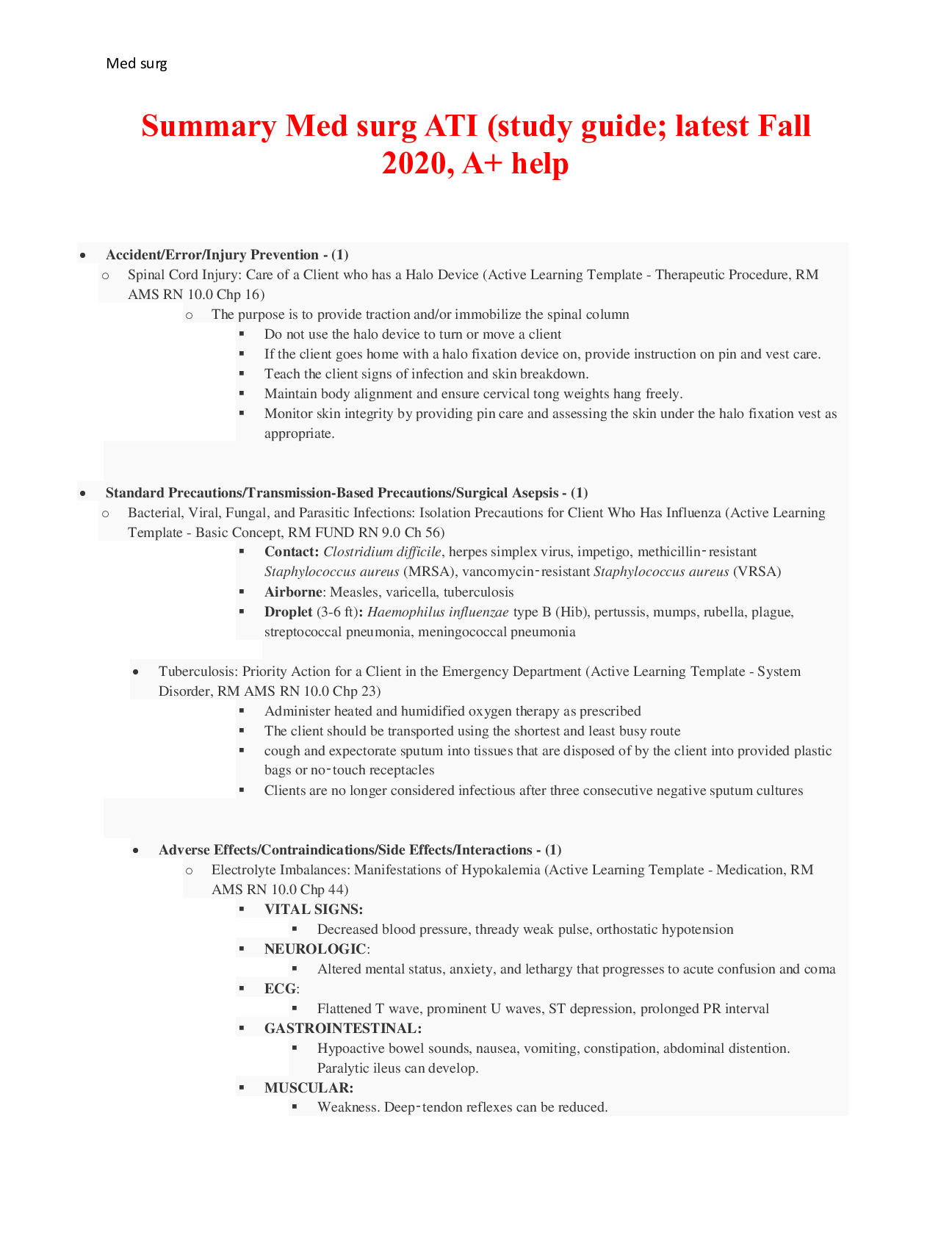
Reviews( 0 )
Recommended For You
*NURSING> Summary > Summary Med surg ATI (study guide; latest Fall 2020, A+ help (All)

Summary Med surg ATI (study guide; latest Fall 2020, A+ help
Summary Med surg ATI (study guide; latest Fall 2020, A+ help
By Nightingale , Uploaded: Jun 25, 2022
$8
*NURSING> Summary > Summary Med surg ATI (study guide; latest Fall 2020, A+ help (All)
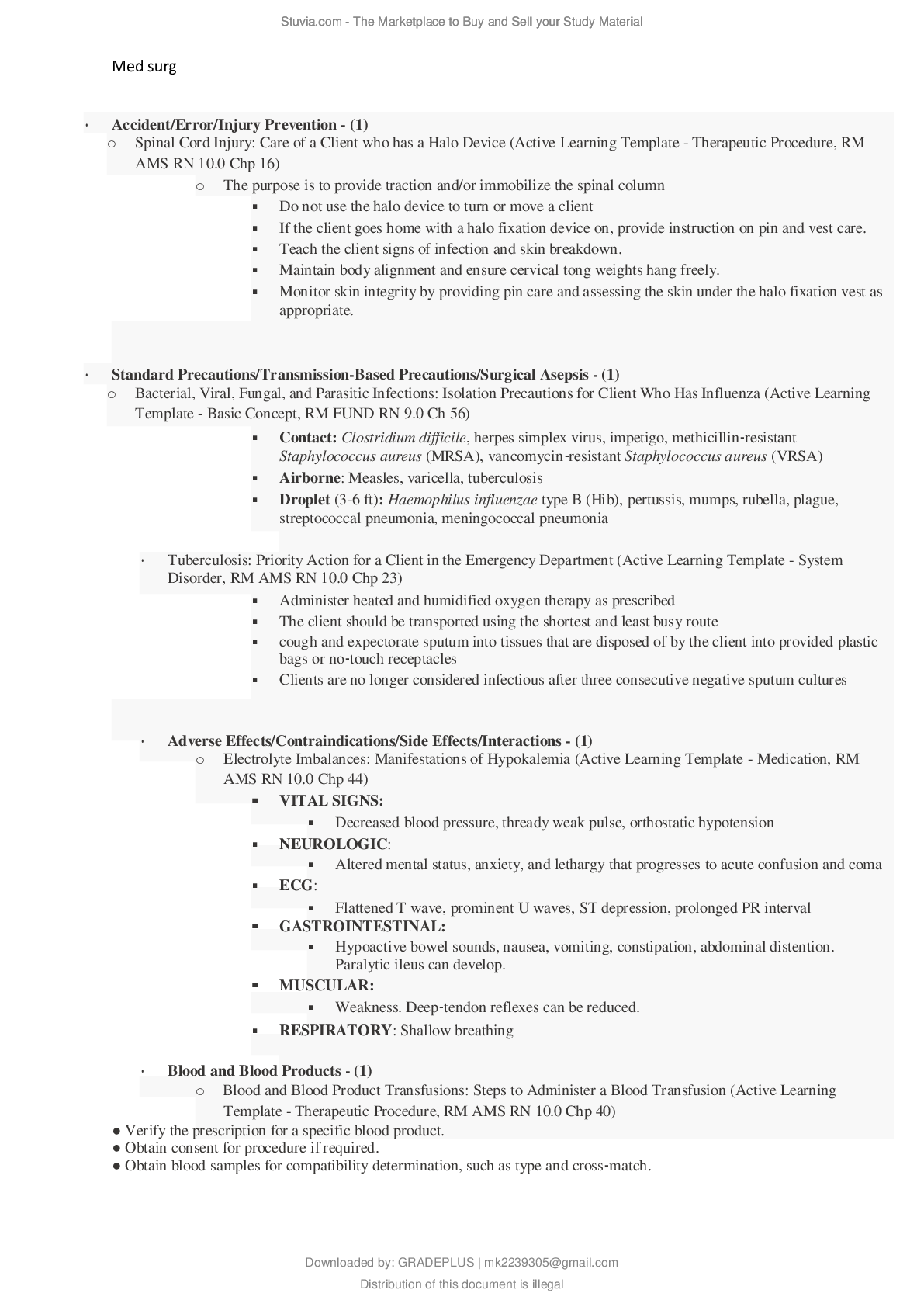
Summary Med surg ATI (study guide; latest Fall 2020, A+ help
Med surg ATI|Solano Community College - NURSING nursing 1 • Accident/Error/Injury Prevention - (1) o Spinal Cord Injury: Care of a Client who has a Halo Device (Active Learning Template - Therapeutic...
By QUIZ BIT , Uploaded: Jun 11, 2021
$8
*NURSING> Summary > Summary Med surg ATI (study guide; latest Fall 2023, A+ help (All)

Summary Med surg ATI (study guide; latest Fall 2023, A+ help
Summary Med surg ATI (study guide; latest Fall 2023, A+ help • Accident/Error/Injury Prevention - (1) o Spinal Cord Injury: Care of a Client who has a Halo Device (Active Learning Template - Therapeut...
By kian biden , Uploaded: Mar 04, 2023
$6
*NURSING> Summary > Summary Med surg ATI (study guide; latest Fall 2023, A+ help (All)

Summary Med surg ATI (study guide; latest Fall 2023, A+ help
Summary Med surg ATI (study guide; latest Fall 2023, A+ help • Accident/Error/Injury Prevention - (1) o Spinal Cord Injury: Care of a Client who has a Halo Device (Active Learning Template - Therapeut...
By kian biden , Uploaded: Mar 04, 2023
$6
*NURSING> Summary > NR 566 / NR566 Advanced Pharmacology for Care of the Family Week 1 Chapter 41 Notes| Hyperthyroidism and Hypothyroidism | Latest 2020 / 2021 | Chamberlain College (All)

NR 566 / NR566 Advanced Pharmacology for Care of the Family Week 1 Chapter 41 Notes| Hyperthyroidism and Hypothyroidism | Latest 2020 / 2021 | Chamberlain College
NR 566 / NR566 Advanced Pharmacology for Care of the Family Week 1 Chapter 41 Notes| Hyperthyroidism and Hypothyroidism | Latest 2020 / 2021 | Chamberlain College Introduction ❖ Thyroid disorders ar...
By nurse_steph , Uploaded: Jan 07, 2021
$6
Computer Science> Summary > Cours sur le paramétrage d'un switch CISCO (All)
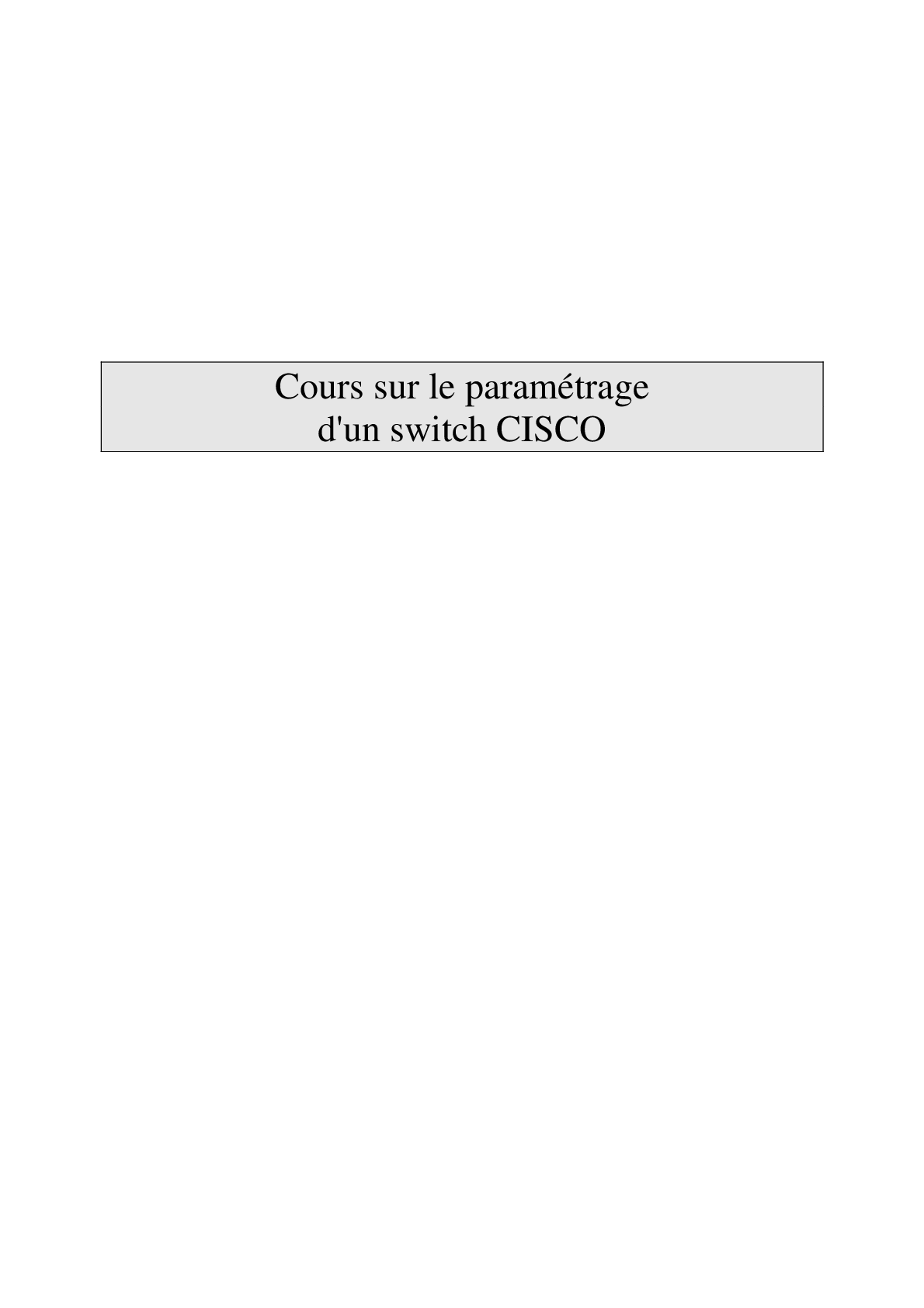
Cours sur le paramétrage d'un switch CISCO
I. SOURCES DE CONFIGURATION : Les commutateurs CISCO peuvent être configurés, simultanément et/ou indépendamment, à partir de plusieurs sources. On peut classer ces différentes sources en deux caté...
By EXCELLENCE NURSING LIBRARY , Uploaded: Dec 29, 2023
$8
WebCe Group Life Insurance> Summary > STERLING INSURANCE ATI SERVICES IC-38 NEW SYLLLABUS (LIFE) (All)
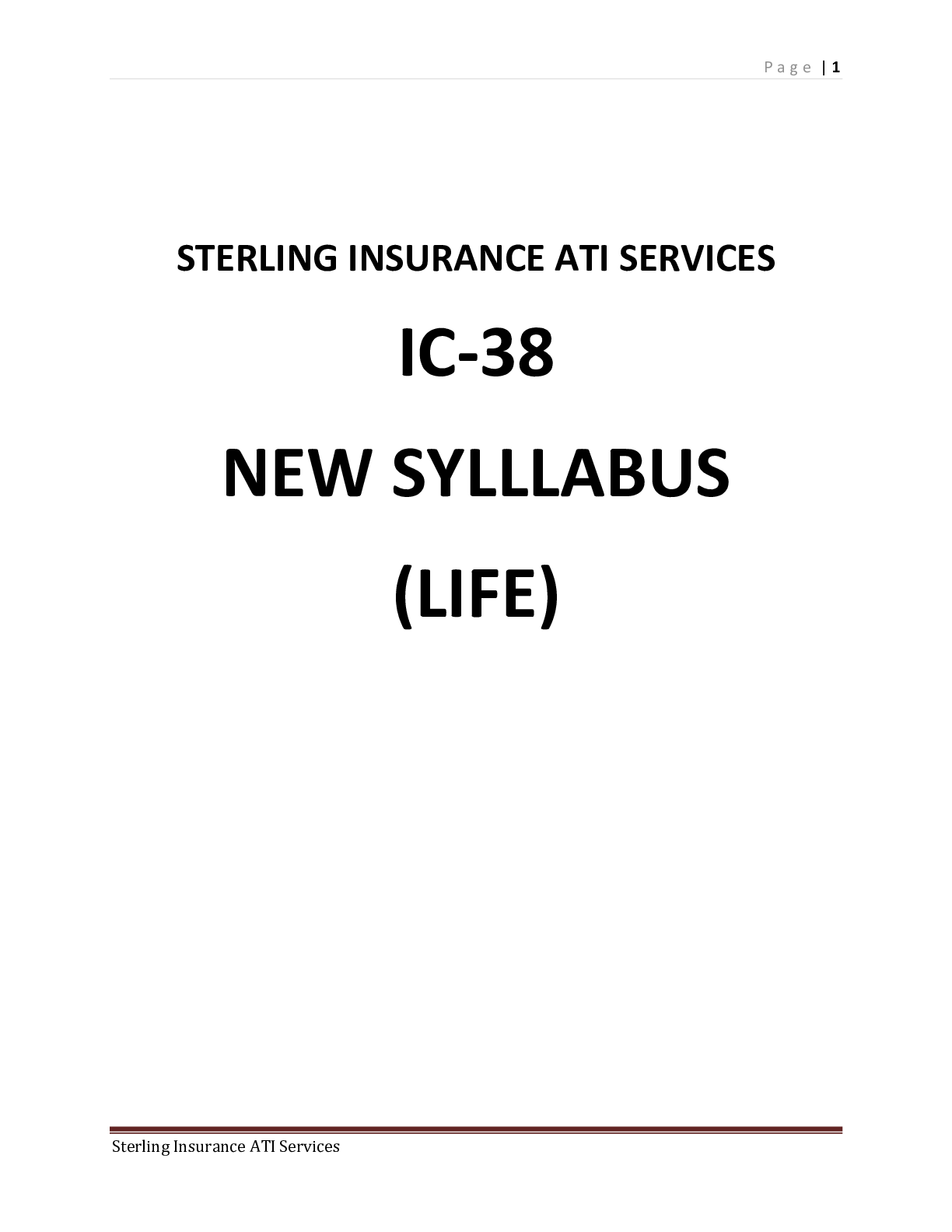
STERLING INSURANCE ATI SERVICES IC-38 NEW SYLLLABUS (LIFE)
CONTENTS Chapter no. Title Page no SECTION 1 COMMON CHAPTERS 1 Introduction to Insurance 3 2 Customer Service 8 3 Grievance Redressal Mechanism 13 4 Regulatory aspects of Insurance Agents 17...
By EXCELLENCE NURSING LIBRARY , Uploaded: Nov 24, 2023
$21
healthcare> Summary > Healthcare transformation a guide for the hospital board member part 10 100% verified study guide 2023 (All)
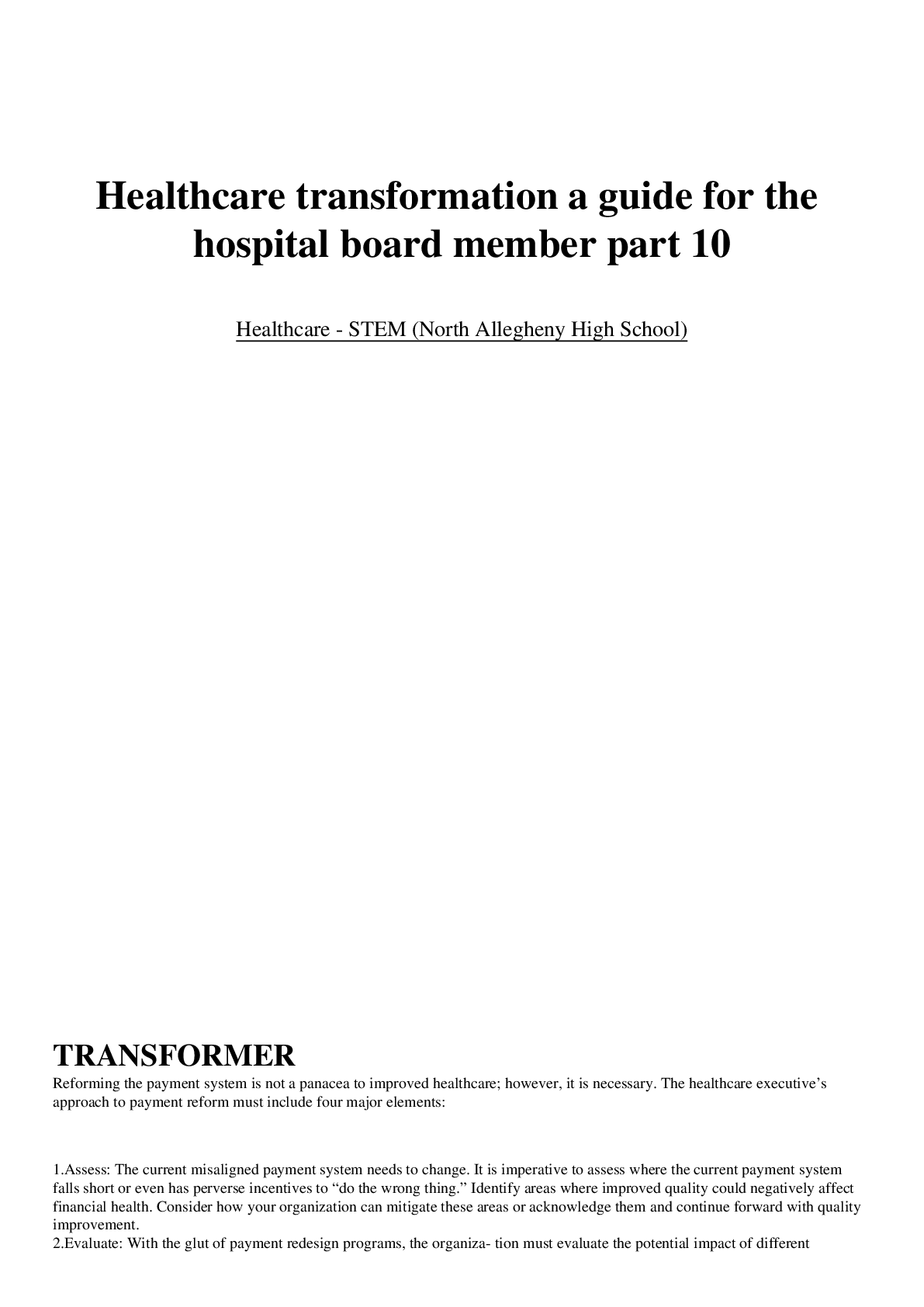
Healthcare transformation a guide for the hospital board member part 10 100% verified study guide 2023
100% verified study guide 2023 TRANSFORMER Reforming the payment system is not a panacea to improved healthcare; however, it is necessary. The healthcare executive’s approach to payment reform must...
By Istudyguide , Uploaded: Nov 21, 2023
$12.5
Agricultural Studies> Summary > Fundamentals of Planning Buildings and Facilities of Animal and Poultry production[ARABIC] (All)

Fundamentals of Planning Buildings and Facilities of Animal and Poultry production[ARABIC]
بعد الإنتهاء من المبادىء الأولية فى كل من الرسم الهندسى وخواص المواد وحساب كمياتها والأحمال الناتجة عنها، سنتكلم فيما يلى وحتى نهاية المقرر عن الجزء الثالث والأكبر من المقرر وهو أسس تخطيط المبانى...
By EXCELLENCE NURSING LIBRARY , Uploaded: Nov 17, 2023
$11.5
*NURSING> Summary > Summary MS2 Nursing Clinical, Week 1 VSIM; V-Sim Carl Shapiro Documentation and Guided Reflection. (All)

Summary MS2 Nursing Clinical, Week 1 VSIM; V-Sim Carl Shapiro Documentation and Guided Reflection.
Summary MS2 Nursing Clinical, Week 1 VSIM; V-Sim Carl Shapiro Documentation and Guided Reflection.
By Rixx Dennis , Uploaded: Feb 01, 2022
$9
Document information
Connected school, study & course
About the document
Uploaded On
Dec 11, 2020
Number of pages
20
Written in
Additional information
This document has been written for:
Uploaded
Dec 11, 2020
Downloads
0
Views
218






